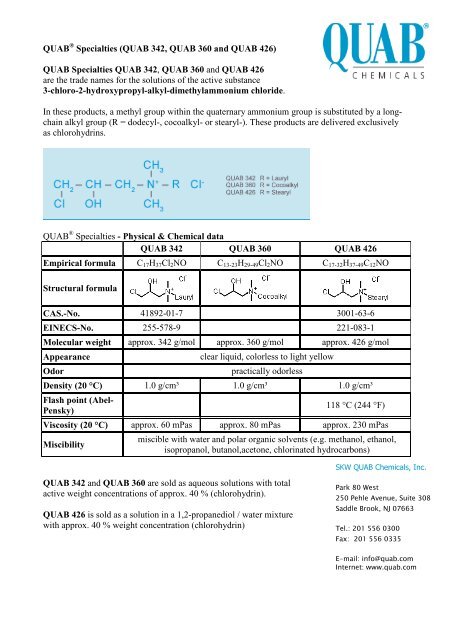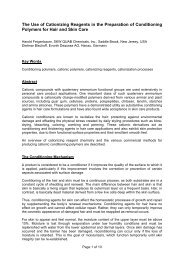Download QUAB ® Specialties product specifications (PDF)
Download QUAB ® Specialties product specifications (PDF)
Download QUAB ® Specialties product specifications (PDF)
You also want an ePaper? Increase the reach of your titles
YUMPU automatically turns print PDFs into web optimized ePapers that Google loves.
<strong>QUAB</strong> <strong>®</strong> <strong>Specialties</strong> (<strong>QUAB</strong> 342, <strong>QUAB</strong> 360 and <strong>QUAB</strong> 426)<br />
<strong>QUAB</strong> <strong>Specialties</strong> <strong>QUAB</strong> 342, <strong>QUAB</strong> 360 and <strong>QUAB</strong> 426<br />
are the trade names for the solutions of the active substance<br />
3-chloro-2-hydroxypropyl-alkyl-dimethylammonium chloride.<br />
In these <strong>product</strong>s, a methyl group within the quaternary ammonium group is substituted by a longchain<br />
alkyl group (R = dodecyl-, cocoalkyl- or stearyl-). These <strong>product</strong>s are delivered exclusively<br />
as chlorohydrins.<br />
<strong>QUAB</strong> <strong>®</strong> <strong>Specialties</strong> - Physical & Chemical data<br />
<strong>QUAB</strong> 342 <strong>QUAB</strong> 360 <strong>QUAB</strong> 426<br />
Empirical formula C17H37Cl2NO C13-23H29-49Cl2NO C17-32H37-49C12NO<br />
Structural formula<br />
CAS.-No. 41892-01-7 3001-63-6<br />
EINECS-No. 255-578-9 221-083-1<br />
Molecular weight approx. 342 g/mol approx. 360 g/mol approx. 426 g/mol<br />
Appearance clear liquid, colorless to light yellow<br />
Odor practically odorless<br />
Density (20 °C) 1.0 g/cm³ 1.0 g/cm³ 1.0 g/cm³<br />
Flash point (Abel-<br />
Pensky)<br />
118 °C (244 °F)<br />
Viscosity (20 °C) approx. 60 mPas approx. 80 mPas approx. 230 mPas<br />
Miscibility<br />
miscible with water and polar organic solvents (e.g. methanol, ethanol,<br />
isopropanol, butanol,acetone, chlorinated hydrocarbons)<br />
<strong>QUAB</strong> 342 and <strong>QUAB</strong> 360 are sold as aqueous solutions with total<br />
active weight concentrations of approx. 40 % (chlorohydrin).<br />
<strong>QUAB</strong> 426 is sold as a solution in a 1,2-propanediol / water mixture<br />
with approx. 40 % weight concentration (chlorohydrin)<br />
SKW <strong>QUAB</strong> Chemicals, Inc.<br />
Park 80 West<br />
250 Pehle Avenue, Suite 308<br />
Saddle Brook, NJ 07663<br />
Tel.: 201 556 0300<br />
Fax: 201 556 0335<br />
E-mail: info@quab.com<br />
Internet: www.quab.com
<strong>QUAB</strong> <strong>®</strong> <strong>Specialties</strong> - Storage<br />
Aqueous chlorohydrin solutions are stable and therefore storable at room<br />
temperature in a pH range of 2-6 for several years without any detectable<br />
loss of activity. At higher temperatures, the pH will be reduced over<br />
time. At storage temperatures below 20 °C (<strong>QUAB</strong> 426) and 10 °C<br />
(<strong>QUAB</strong> 342 and <strong>QUAB</strong> 360), waxy like solids may crystallize from<br />
the solution.<br />
<strong>QUAB</strong> <strong>®</strong> <strong>Specialties</strong> - Materials for Transport & Storage<br />
Suitable Materials:<br />
Stainless steel types, 316L and 316TI (DIN 1.4571) are<br />
basically suitable for transport containers but are<br />
recommended for storage only with restrictions. Pickling of<br />
containers and pipes with attention to welds is mandatory.<br />
These materials are subject to pitting after prolonged<br />
periods of contact and at elevated temperatures. However,<br />
since transport containers are not subject to prolonged contact, these materials may be used for<br />
<strong>QUAB</strong> <strong>Specialties</strong>. Plastic containers may be used in all cases.<br />
Quab recommends a coating for storage tanks made of stainless steel types, 316L and 316TI (DIN<br />
1.4571). Alternatively, fibre reinforced plastic tanks or other coated storage containers may be used.<br />
Suitable materials for <strong>QUAB</strong> <strong>Specialties</strong> include polyester, polyethylene, PVC, heat cured phenolic<br />
resins or epoxy resins, neoprene, Buna S and Buna N. Enameled containers and tanks may also be<br />
used. Any damage in the coating must be repaired.<br />
Unsuitable Materials:<br />
For <strong>QUAB</strong> <strong>Specialties</strong>, containers made of boiler plate H II, aluminum (99.5) and stainless steel<br />
types, 304L and 321 (DIN 1.4541) are unsuitable. Test samples of stainless steel types, 304L and<br />
321 (DIN1.4541) show pitting.<br />
<strong>QUAB</strong> <strong>®</strong> <strong>Specialties</strong> - Packaging<br />
Content <strong>QUAB</strong> 342 <strong>QUAB</strong> 360 <strong>QUAB</strong> 426<br />
PE-drums 200 kg<br />
IBC 1000 kg —<br />
Products listed herein are sold<br />
under applicable laws and<br />
regulations.<br />
Sale of some <strong>product</strong>s may be<br />
prohibited in certain areas.<br />
SKW <strong>QUAB</strong> Chemicals, Inc.<br />
Park 80 West<br />
250 Pehle Avenue, Suite 308<br />
Saddle Brook, NJ 07663<br />
Tel.: 201 556 0300<br />
Fax: 201 556 0335<br />
E-mail: info@quab.com<br />
Internet: www.quab.com
<strong>QUAB</strong> <strong>®</strong> <strong>Specialties</strong> - Specifications<br />
<strong>QUAB</strong> 342 <strong>QUAB</strong> 360 <strong>QUAB</strong> 426<br />
Chlorohydrin content 38 % 38 % 38 %<br />
Epoxide content 500 ppm 500 ppm 500 ppm<br />
Active content* (as chlorohydrin) 38 % 38 % 38 %<br />
Glycol content** 2.5 % 2.5 % n.s.<br />
Epichlorohydrin(ECH) 10 ppm 10 ppm 50 ppm<br />
1,3-Dichloropropanol 100 ppm 100 ppm 1000 ppm<br />
pH*** 2 - 6 2 - 6 2.5 - 6.5<br />
Additional information (not part of the <strong>specifications</strong>)<br />
Water 55 - 58 % 55 - 58 % 29 - 31 %<br />
1,2-Propanediol — — 23 - 28 %<br />
* Epoxide and chlorohydrin together amount to the active content<br />
** <strong>QUAB</strong>-glycol is inert in cationization reactions<br />
*** Undiluted solution<br />
n.s. not specified<br />
<strong>QUAB</strong> <strong>®</strong> <strong>Specialties</strong> - Specifications<br />
For detailed safety, handling and toxicology information see the corresponding material safety data<br />
sheets, which are available upon request!<br />
The substances are corrosive to the eyes and irritating to the skin. Basically the same safety<br />
measures for <strong>QUAB</strong> 188 and <strong>QUAB</strong> 151 apply to the <strong>QUAB</strong> <strong>Specialties</strong>.<br />
<strong>QUAB</strong> 342, <strong>QUAB</strong> 360 and <strong>QUAB</strong> 426 are toxic to fish. Precautions must therefore be taken to<br />
prevent this <strong>product</strong> and its by-<strong>product</strong>s from entering the aquatic environment.<br />
The <strong>QUAB</strong> specialty <strong>product</strong>s have not only cationic but also surfaceactive<br />
properties which are attributable to the long-chain alkyl groups.<br />
The dodecyl, cocoalkyl or stearyl groups lend hydrophobic (lipophilic)<br />
properties to the polymers modified by these <strong>QUAB</strong> reagents. This<br />
may cause foam formation when aqueous solutions are handled,<br />
particularly if there is strong mechanical agitation.<br />
SKW <strong>QUAB</strong> Chemicals, Inc.<br />
Park 80 West<br />
250 Pehle Avenue, Suite 308<br />
Saddle Brook, NJ 07663<br />
Tel.: 201 556 0300<br />
Fax: 201 556 0335<br />
E-mail: info@quab.com<br />
Internet: www.quab.com



